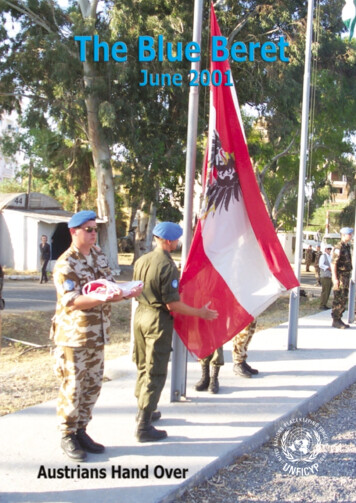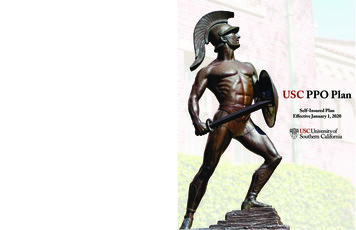
Transcription
Published monthly by the PublicInformation Office of the UnitedNations Force in Cyprus, HQUNFICYP, PO Box 21642, Nicosia,Cyprus.Tel: (02) 864550/864416/864408Fax: (02) 864461Editorial TeamBrian KellyMaj. Dezső KissMiriam TaylorPhotographySSgt Michal ZurbolaContingent PhotographersUnit Press OfficersSector 1Maj. Alejandro AlvarezSector 2Lt. Anna Fox’Sector 4Lt. LubošKlímaCapt. Béla AndrásiCapt. Tanja PecnikHQ UNFICYP WO2 Val RamsayUNCIVPOLGarda Kevin KeysSupt. Romeo GyergyakUN FltLt. Mariano GarbiniMFRCapt. Fernando MendezFMPU1/Lt. Gerard VerhulstThe Blue Beret is the in-house journal ofthe United Nations Peacekeeping Forcein Cyprus. The views expressed are thoseof the authors concerned, and do notnecessarily conform with official policy.Articles of general interest are invitedfrom all members of the Force. Photographs, together with captions, shouldaccompany the articles.The copyright of all material in this journal is vested in United Nations Publications. Any article or illustration may bereproduced with the written permissionof the Editor.editorialThe magazine for UNFICYP’s civilian, military and police personnelTHE BLUE BERETE-mail: blueberetcyprus@hotmail.comWeb site: www.unficyp.orgIn this issue we extend a special salute toAustria, one of the first countries tocontribute troops to UNFICYP back in1964. The June departure of the contingentfrom Sector 4 ends an historic 24-yearassociation by Austrian peacekeepers withFamagusta.We are glad to see that Austria willmaintain its record of continuous service inUNFICYP because of the stalwarts whowill remain to keep the flag flying here atForce HQ at least until 2004.On 18 June, Lt. Col. Gunter KienbergerAustrian Contingent Commander handedover command of UNFICYP’s Sector 4 toLt. Col. Milan Kovac, CommandingOfficer of the newly arrived SlovakContingent.At the same time, the small contingent of29 Slovenian peacekeepers wrapped up itsfive-year stint in the sector.The departure of the Austrians andSlovenians reflects a contemporary andpressing military and peacekeeping reality,the need to meet and sustain troop andresource commitments elsewhere.In the case of Austria, this includes servicewith KFOR in the Balkans, and withUNDOF on the Golan Heights. BothAustrian and Slovenian assets are on call aswell for the planned European RapidReaction Force.Both have served Cyprus and UNFICYPwell.IN THIS BLUE BERET:Contents2Editorial/Contents . . . . . . . . . . . . . . . .2Austria and Slovenia withdraw . . . . . . .3Sector 2 . . . . . . . . . . . . . . . . . . . . . .4/5FMPU . . . . . . . . . . . . . . . . . . . . . . . . . .6Crowd Control Training . . . . . . . . . . . .7The S-G speaks out on AIDS . . . . . . .8/9Sector 1 . . . . . . . . . . . . . . . . . . . . . . . .10UNCIVPOL . . . . . . . . . . . . . . . . . . . .11UNFICYP lends a hand to studentswho lend a hand . . . . . . . . . . . . . . . .12How to avoid fire/ESKOBAR/Argentinian Ambassador visits . . . . .13Sport . . . . . . . . . . . . . . . . . . . . . . .14/15Front Cover:Departure of AustriaBack Cover:Departure of SloveniaJune 2001 - The Blue BeretAustria and Sloveniawithdraw -Slovakiatakes overAchange of command ceremony held at 18.00hours on 18 June 2001 in Famagusta marked thehanding over of command of UNFICYP’s Sector4 by Austrian Contingent Commanding Officer, Lt. Col.Gunter Kienberger, to Lt. Col. Milan Kovac, Commanding Officer of the recently arrived Slovak contingent.The handover ends 24 years of the Austrian peacekeepers’ association with Famagusta.Also leaving Sector 4 was the small SlovenianContingent of 29. They had served in the same sectoralongside 114 Hungarians and 245 Austrians since theirarrival in 1997. The Hungarians remain on and will nowwork with the new Slovak Contingent, which assumedcommand of the sector with effect from 18 June.UNFICYP Chief of Mission Zbigniew Wlosowiczpaid tribute to the departing contingents, thanking themfor their contributions to the UN peacekeeping effortduring their service in Cyprus.UNFICYP Force Commander, Maj. Gen. VictoryRana, the Austrian Chief of Defence Staff, Gen. HorstPleiner, and the State Secretary of the Ministry ofDefence Slovenia, Mr. Janko Dezelak, attended theceremony. Austria’s Ambassador to Greece and Cyprus,Dr. Rene Pollitzer, Slovenia’s Ambassador to Greeceand Cyprus, Mr. Borut Mahnic, the Slovak Ambassadorto Cyprus, Mr. Dusan Rozbora, Hungary’s Chargéd’Affairs and Representative in Cyprus, Mr. LaszloNikicser, the British High Commissioner, H.E. Mr.Edward Clay CMG, and the British Defence Attaché,Col Crichton Wakelin were also present.The downsizing and eventual withdrawal of the Austrian and Slovenian forces from service with UNFICYPis because of their need to meet and sustain troop andresource commitments elsewhere. In the case of Austria,this includes service with KFOR in the Balkans and withThe Force Commander, CommanderSLOVCON and CommanderAUSCON during thehandover ceremonyUNDOF on the Golan Heights. Austrian and Slovenianassets are also on call for the planned European UnionRapid Reaction Force.The Slovak Contingent with 280 troops takes overfrom the Austrians and Slovenians. Slovakia has considerable experience in international peacekeepingmissions, having contributed troops and/or observers tomissions in the Golan Heights, the former Yugoslavia,Eritrea, Iraq and East Timor.Austria was among the very first countries tocontribute to UNFICYP, deploying a field hospital with54 soldiers in the Kokkino Trimithia area west ofNicosia in April 1964. In May 1972, an Austrianinfantry battalion with 283 troops was sent to the island.The new battalion was deployed initially to the districtof Paphos, but in 1973 moved tothe district of Larnaca beforemoving on to Famagusta in1977.Since the inception of the mission, a total of 16,321 Austrianmilitary - plus 276 UN civilianpolice -- have served in Cyprus.In that time, 15 have died -three as the result of an air attackin 1974.Thanks to the presence of asmall number of personnel whowill remain in the UN Headquarters of UNFICYP in Nicosia, Austria will maintain itsrecord of continuous service inThe outgoing Commanding OfficerUNFICYP at least until 2004.salutes his guestsThe Slovenian engagement onthe island ends this year.June 2001 - The Blue Beret3
4Brigadier Val Batchelor is currently DirectorStaff and Personnel Support (Army), andthe highest ranking female officer in theBritish Army.Brig. Batchelor arrived at HQ UNFICYP topresent Long Service and Good Conduct Medals,an honour one of her colleagues jokingly says isbestowed on personnel with “15 years ofundetected crime to their name”.A quietly spoken woman with a gentle natureand no family military background, shejoined the ranks at 17 years of age,first serving as a private. What made herchoose the army as a career? “Well, Iknew from a very early age that a 9-5job was definitely not for me. I have anadventurous spirit and I wanted a careerwith a challenge -- and I certainly foundthat!” But why didn’t she enlist directlyas an officer? “I knew I wanted to spenda few years as an NCO -- just to havefun with no responsibility. And thisexperience came in very useful, since Ilearned how soldiers live and work.”Then three years later, she was promoted to the rank of Corporal in theWRAC. Asked how she felt, serving ina predominantly male environment, shereplied: “It was definitely a man’sworld. I felt frustrated because therewere things I wanted to do in the armywhich I was not allowed to -- forexample, I was with the IntelligenceCorps, but I could not progress in thisfield because, being a woman, the highestfemale rank I could reach was a Captain.“However, integration of the WRACinto the British Army took place in1992, and that is when equal opportunities werefinally offered to female soldiers. Then we (menand women) were in direct competition! Havingsaid that, I must add that as far as my own careeris concerned, aside from the initial frustrations ofnot being able to compete fairly with my malecounterparts, I have been treated very well.”Following integration, Brig. Batchelor transferred into the Adjutant General’s Corps. For herefforts during the amalgamation of the WRACinto the British Army, she was awarded theO.B.E., which she describes as the highlight of hercareer.This was Brig. Batchelor’s first visit to the SPSclerks of UNFICYP, which she has thoroughlyenjoyed. She was also taken on a short tour ofSector 2 where she was extremely well hosted by12 Regiment. “The boys in Sector 2 have a verydifficult job to do here, and it has been a veryinformative visit for me. I now have a greaterunderstanding of the pressures they are under andthe conditions under which they work.”LS & GC medal recipients pictured below wereWO2 Paul Milton (left) and WO2 Val Ramsey of theBritish Contingent serving with UNFICYPJune 2001 - The Blue Beret12 RegimentRoyal Artillery12 Regiment has deployed to Cyprus to take overfrom the Queen’s Royal Lancers on completion oftheir six-month tour. The Regiment took overSector 2 on 7 June, and will remain until 12 December, when it will be replaced by 32 RegimentRoyal Artillery.Also attached to the Regiment during the tourare 3/29 Battery from 4th Regiment Royal Artilleryand a troop of Engineers from 9 ParachuteSquadron in Aldershot.Missile loadingA Brief History12 Regiment Royal Artillery is one of four AirDefence Regiments in the British Army and is theonly Air Defence Regiment based in Germany. Itwas initially formed in 1942 as part of 15 FieldBrigade and served in Iraq, then Persia, Syria andItaly during WWII. Then in June 1946, it wasredesignated 15 Anti Tank Regiment.From 1947-1951, the Regiment served in theMediterranean and North Africa as 12 Anti-TankRegiment. On redeployment to Celle, Germany, itwas renamed 12 Anti-Aircraft Regiment.The Regiment converted to Rapier in 1972 andthen in 1996 to the High Velocity Missile (HVM)system. It has been based in a number oflocations, both in the UK and in Germany, withtours being conducted all over the world includingthe Falklands, Northern Ireland, Cyprus, the Gulfand more recently Kosovo.The Regiment is grouped into T(HQ) (ShahSujah’s Troop) Battery and three equipmentbatteries: 12 (Minden) Battery, 9 (Plassey) Batteryand 58 (Eyre’s) Battery. Each Battery has a training affiliation with different Brigades. In additionthere is a REME workshop and RLC storessection.The Regiment has been located in DempseyBarracks, Sennelager, Germany since movingfrom Dortmund in 1995.HVM - linefiring at theRoyal ArtilleryRangeManobierSector 2Sector 2BrigadierBatchelorVisitsRegimental InformationCaptain General: Her Majesty Queen Elizabeth IIMaster Gunner General: Sir Alex Harley KBE CBMotto of the Corps: Ubique (Everywhere), Quo Fas Gloria Ducunt (Where Right and Glory Lead)Regimental March: The Royal Artillery Slow MarchPatron Saint: St BarbaraCOMMANDING OFFICER SECTOR 2Lt Col IJ Ian BaylessLt. Col. Ian Bayless assumed command of 12 Regiment inNovember 1999. Prior to that he was a Staff Officer in the Lt. Col. Bayless (right) taking over commandof Sector 2Directorate of Military Operations. His commissionedservice began in J Battery, Royal Horse Artillery (RHA).He has since served in 40 Regt, 45 Regt, 307 Bty and wasa Battery Commander in 1 RHA.Lt. Col. Bayless attended the Army Staff College in 1991and has experience in numerous staff posts, completingoperational tours in Northern Ireland and Bosnia.Lt. Col. Bayless is married to Wendy and they have twosons, George aged 7 and William aged 5. His interestsinclude sailing and poultry.June 2001 - The Blue Beret5
FOR SAFEDRIVING INCYPRUSBy Sgt. Rick WhiteheadFMPUIarrived in Cyprus on 23 June 2001 for a sixmonth UN tour. Previously, I was a Unit RoadSafety Officer at the Royal Military PoliceTraining School in Chichester, England. Part ofmy job was the promotion of road safety awareness to young Royal Military Police recruitsundergoing training, and also to more experienced NCOs attending the School for AdvancedTraining.Prior to my arrival, the School averagedbetween seven and ten major accidents a year. Iam glad to say that up until 23 June, only oneblameworthy accident, and one unattributableaccident were reported in a two-year period.Curiously, the one blameworthy accident involveda soldier from, would you believe it, Cyprus! Hereare some basic tips for safe driving in Cyprus. Ifyou follow them, I cannot guarantee that you willnot be involved in an accident, but at least thechances will be reduced.I.Do not copy local driving habitsLocal drivers are not inferior drivers, just different. If you try and copy their (sometimes) aggressive style of driving, you are more likely to beinvolved in an accident. This is because you willnot be used to driving in this way (or at least youshouldn’t).II.Drive defensivelyNever assume that you know what the other driveris going to do. Just because they are indicating toturn left, does not always mean they will. Wehave all at some time forgotten to indicate, orforgotten to turn the signal off. Anticipate that thecar emerging from the junction up ahead may notstop.III.Reduce your speedDrivers in all countries must get bored withhearing this, but while drivers continue to speed,Police Forces will continue to remind them. It isa fact that slowing down reduces your chances ofbeing involved in an accident. SLOW DOWN.IV.NEVER drink and driveIf you are driving a UN vehicle, you must not haveany alcohol in your body. Remember that drinkfrom the previous night’s merriment may still bein your system. It takes a good eight hours for allthe alcohol in your system to be removed (goodvalue!). If in doubt, don’t drive. It is FMPUpolicy that all persons involved in a trafficaccident will be breathalized regardless of who isat fault. If you are driving in the north of theisland, remember that the drink/drive limit isconsiderably less than in the south. Nil alcohol isby far the safest bet.6V.Always wear your seatbeltYes, it’s a fact that they make you
Information Office of the United Nations Force in Cyprus, HQ UNFICYP, PO Box 21642, Nicosia, Cyprus. Tel: (02) 864550/864416/864408 Fax: (02) 864461 E-mail: blueberetcyprus@hotmail.com Web site: www.unficyp.org Editorial Team Brian Kelly Maj. Dezső Kiss Miriam Taylor Photography SSgt Michal Zurbola Contingent Photographers Unit Press Officers Sector 1 Maj. Alejandro Alvarez Sector 2 Lt.











